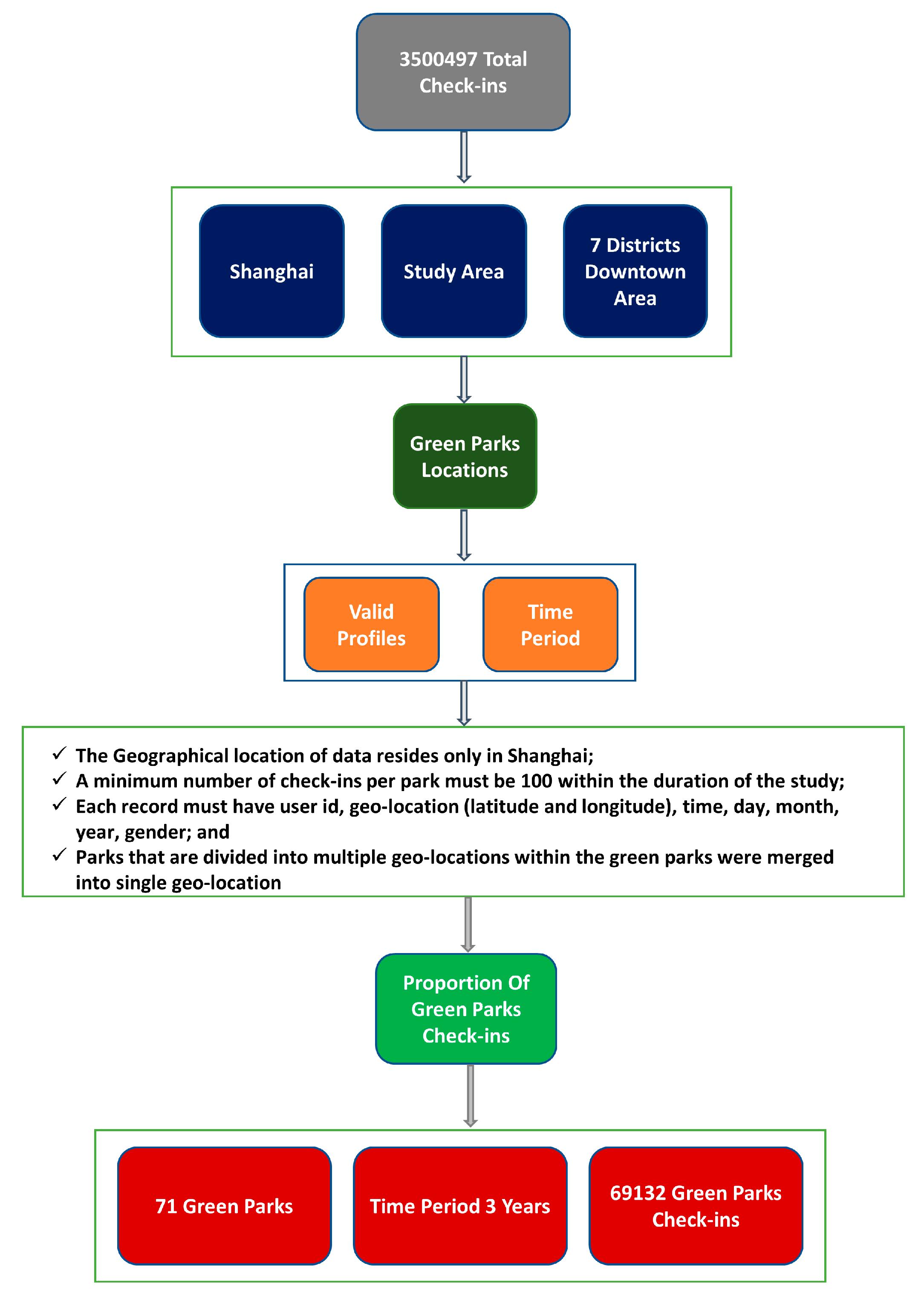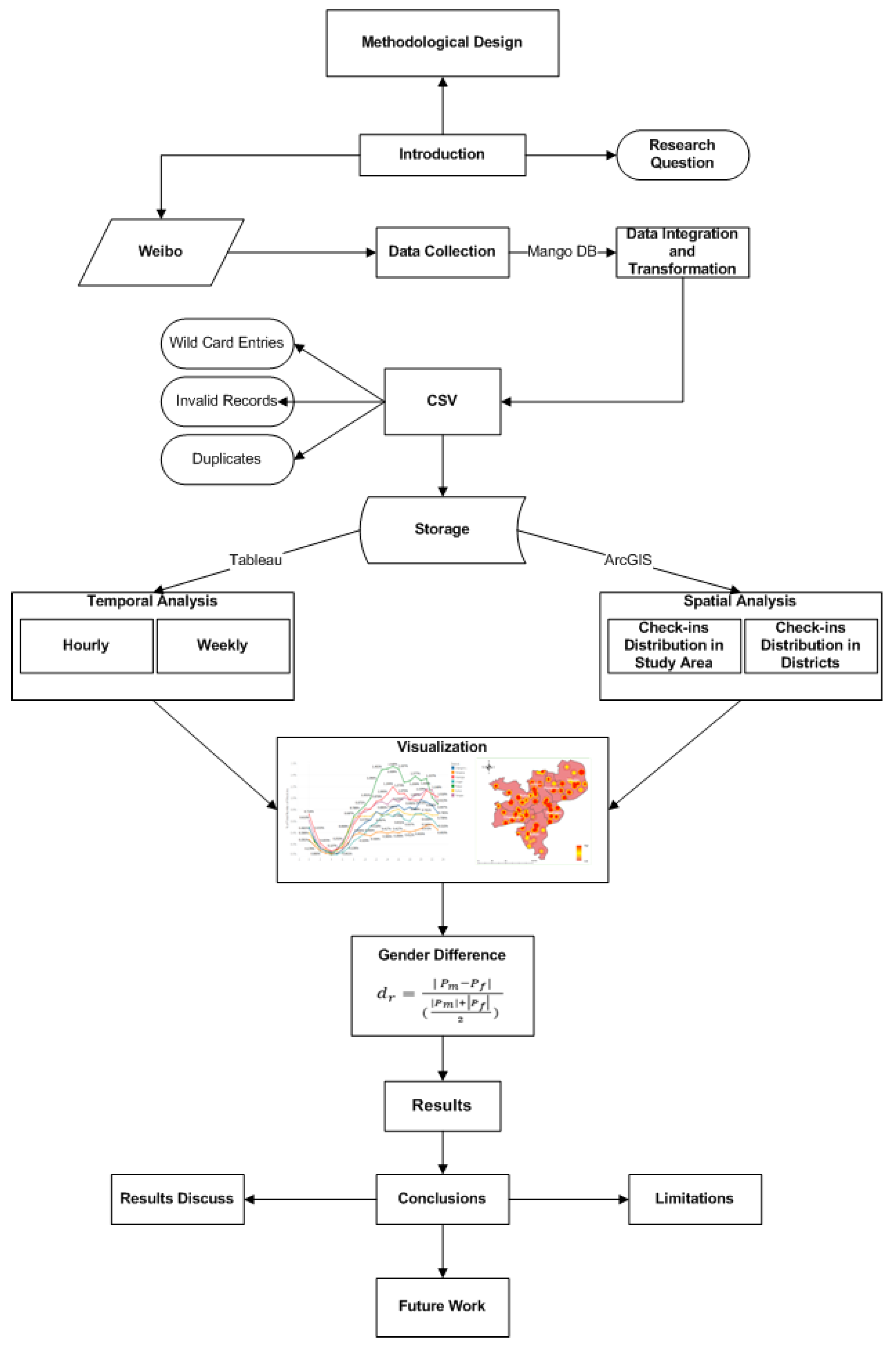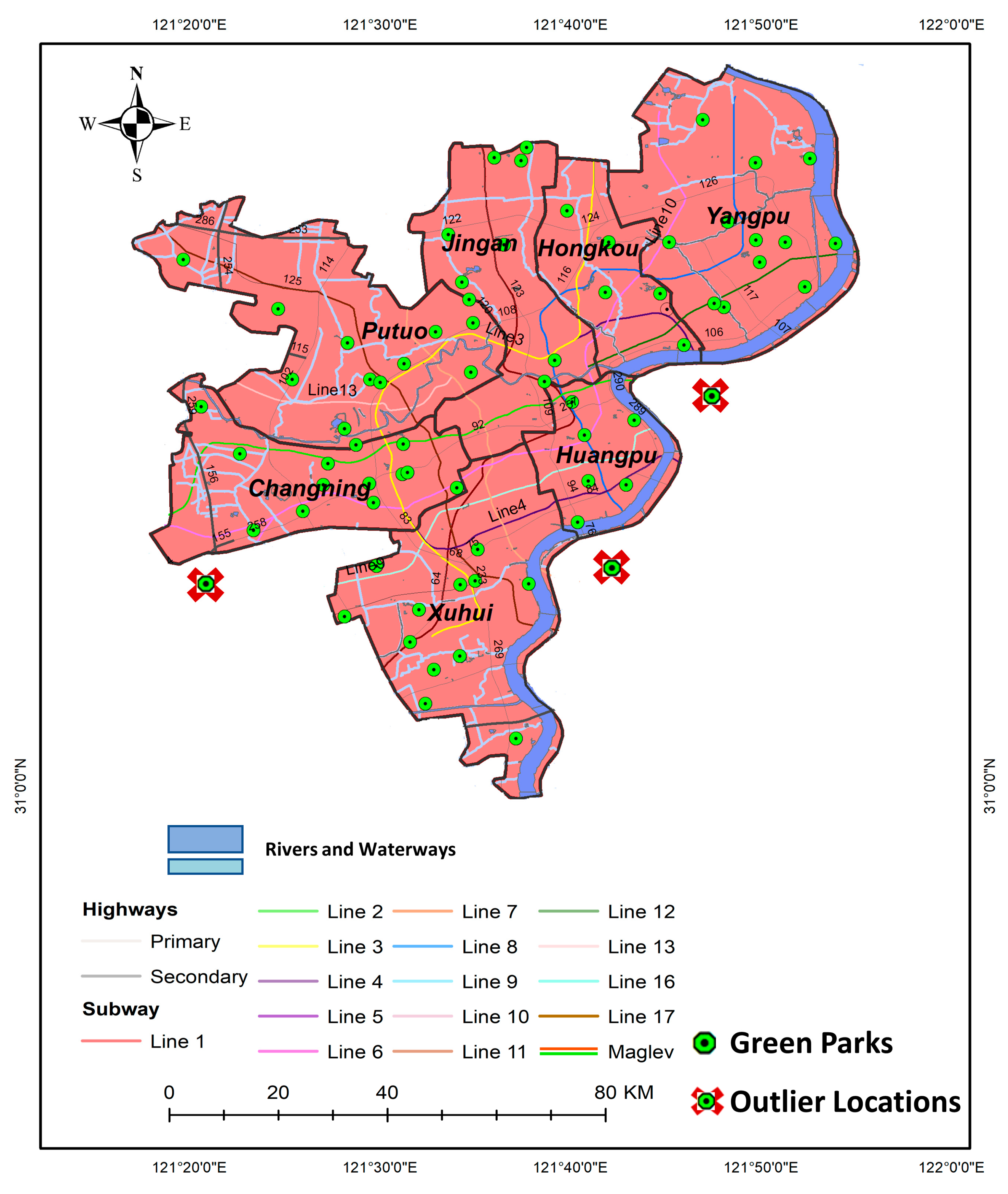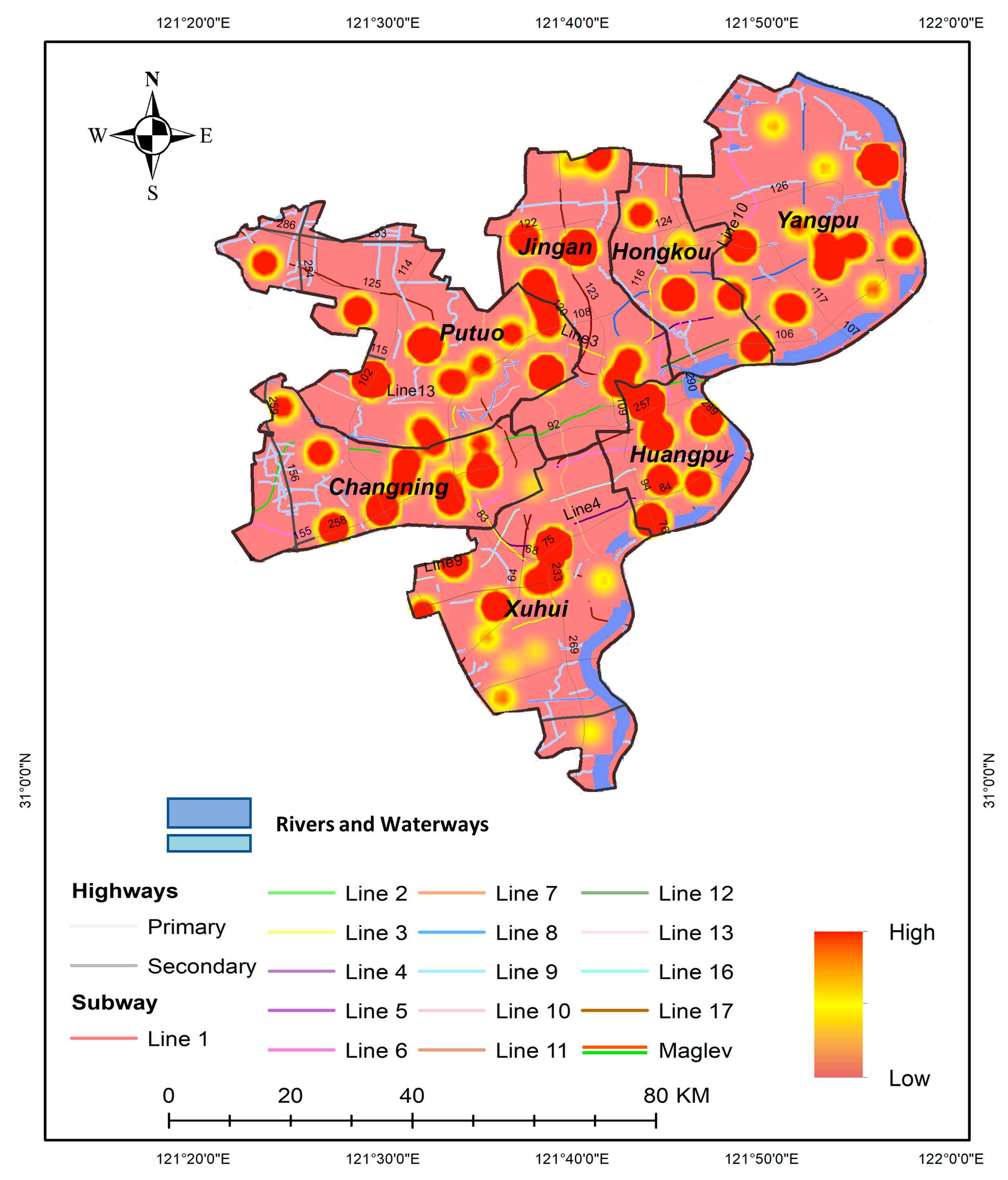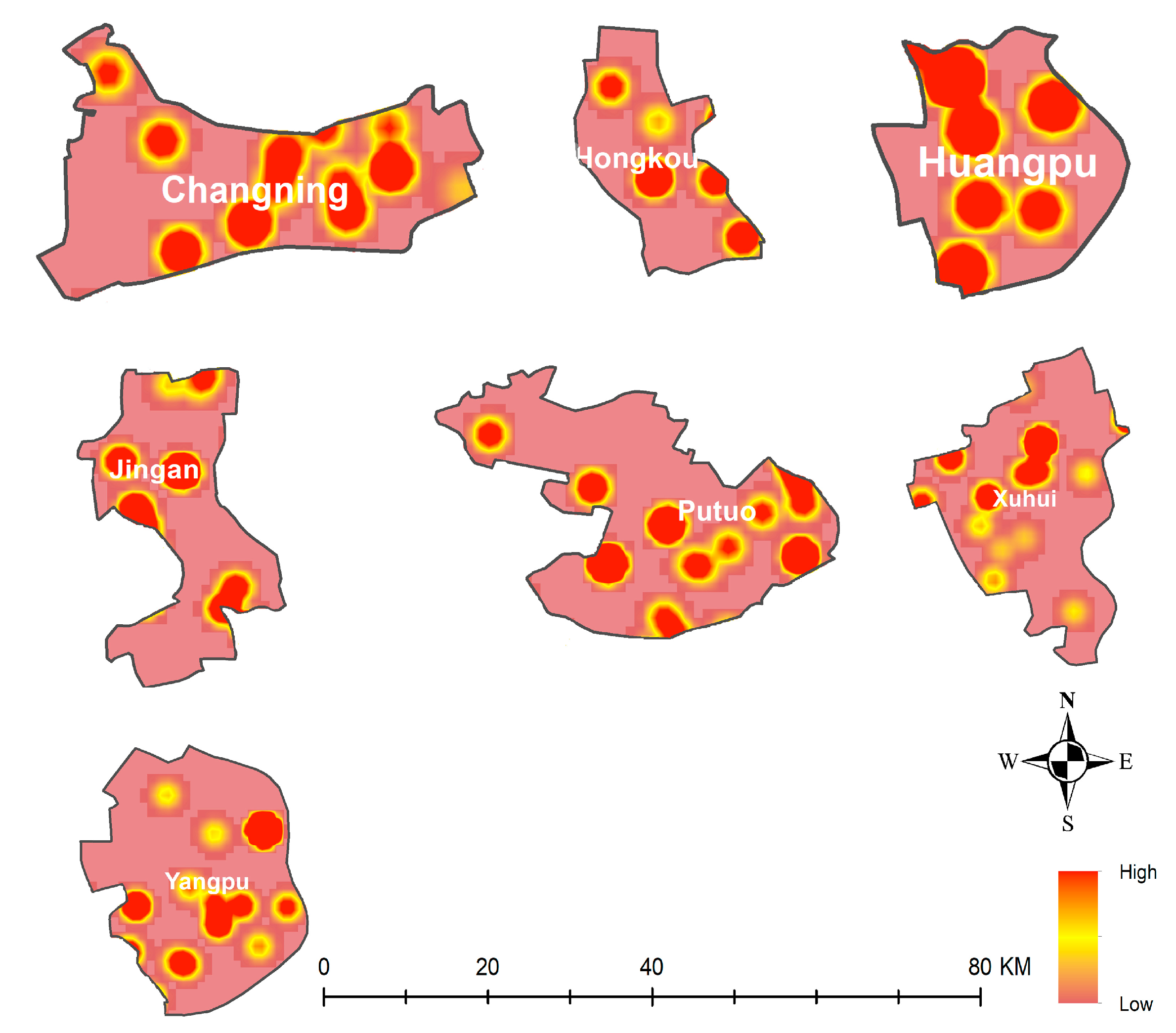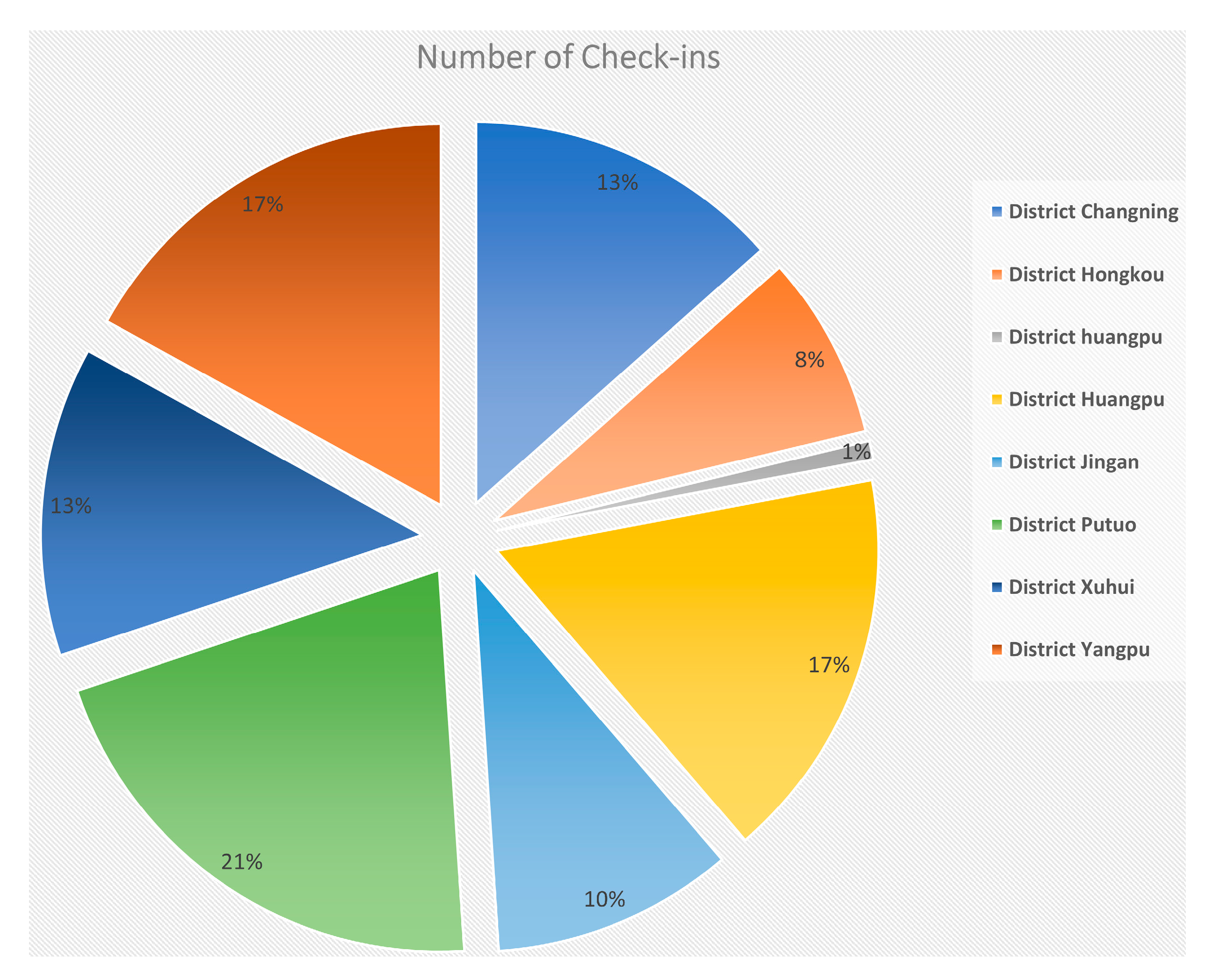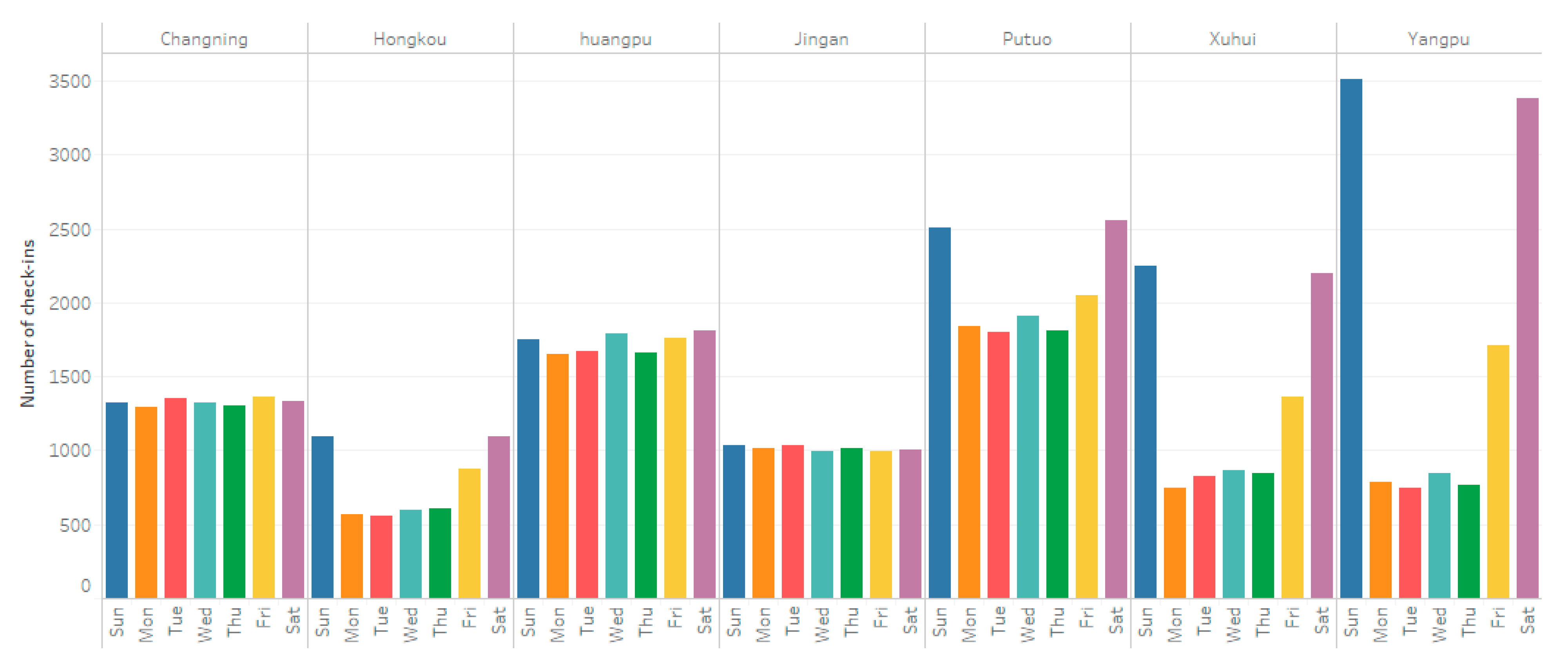1. Introduction
Urban areas are generally marked by downgraded ecosystems, rising environmental damage, higher temperature, and a decreasing number of green parks. Urban green spaces (UGS) are important for improving quality of life in metropolitan areas, balancing thermal comfort with thermal budget [
1], and helping the public heal from the physical and emotional pressures of their daily lives [
2]. Green spaces in an urban environment are vital for improving living conditions by improving air quality and aesthetics, which eventually lead to higher real-estate values and a reduction in energy use for cooling. Urban green spaces can also be applied as a cumulative resource for enhancing the sustainability of urban areas [
3]. They also provide children with much-needed space to play, significant for their social, cognitive, and mental functions [
4].
Urban green spaces—in general, parks—offer many advantages to people’s well-being, such as psychological and social well-being and physical health [
5,
6,
7]. Visits to green parks provide an opportunity to experience the extra benefits of “natural” environments directly, especially for people with limited natural contact. Consequently, quantifying the visits of residents to urban green spaces and recognizing the factors that influence their visits are vital for urban park management and planning. It is important to measure visitation of parks and urban green spaces to recognize their recreational interests and define the factors that influence them. Visitor polls, on-site counters, and direct observation are traditional methods for estimating the number of visitors [
8,
9]. These methods of organized observation usually pick a representative sample of urban green spaces and collect information about green park use—for example, visitation numbers and features, activities, and behavior of green park visitors. However, these approaches are typically time-consuming and site-specific and, therefore, have restricted spatial coverage [
10]. The advent of free social media data offers new methods of calculating urban green park visits. Data collected from social media and other “big data” reliable sources grow in size every year and can be utilized to research how the public interact with actual environments and to accurately assess individual preferences through time and space [
11].
The World Health Organization (WHO) reports on the environment, urban planning, and health released in 2010–2016 reveals that green spaces can positively affect physical activity, social and psychological well-being, improve air quality, and reduce the exposure to noise [
12,
13]. Epidemiological research has used a wide range of methods to calculate the positive impact of green parks’ accessibility and availability on health. Due to the ability of urban green spaces to act as an environment for promoting health, it is essential to summarize available evidence, recognizing, where possible, the underlying mechanisms that contribute to positive and negative health outcomes of green spaces. Recent developments in social media analysis based on geographic information systems (GIS) provide an opportunity to examine spatial and temporal, and even affective dimensions of the behavior of users, including public spaces and visits to parks [
14,
15]. However, some of these analyses still have drawbacks, because only a relatively small number of social media posts are analyzed manually.
The kernel density estimation (KDE) method was used to model geolocation data spatially and offers an additional particular and comfortable structure for spatial estimation of density. The method was used for the assessment of environmental attributes—for example, healthcare properties [
16], the diet environment [
17], and green space advantages. It boosts access or measuring distance by transforming point data into something similar to a nonstop surface and allowing the density of the characteristic to be measured at any point on the map’s surface [
18]. In this research, we expected to examine the effects on visitation rates of users’ check-in behaviors to green spaces. We utilized a sample of data to research green park-related check-in behaviors, including likes and dislikes, as a summary of the behavior or preferences of the general public in various activities while using park resources. Similarly, the aim of the study is to address the following questions: (i) Is using the social media network dataset feasible for this kind of environmental studies? (ii) How often does the time of day influence the behavior of the general public in green parks? (iii) Which district is the center of activities in the city center of Shanghai? To properly grasp the link between green parks and visitor behavior, we analyzed users’ spatiotemporal trends in urban green spaces using a large-scale dataset from July 2014 to June 2017, with almost 70,000 check-ins. Our main results indicate the user check-in distribution in different green parks and exciting behavioral changes based on the time of day in 24 hours and the day of the week. We also investigated the gender difference among districts and days by applying the relative difference formula. By examining these factors, we could analyze the use of urban green parks and its variance across a range of temporal scales. This method of capturing visitor activity in urban green spaces is an attempt to solve the drawbacks of previous studies. This method paves the way for socioecological research using crowdsourced and social network data instead of relying on the results of subjective coverage and observational data.
4. Results
For this analysis, 71 green parks locations were chosen after processing the data collected from Weibo in the city center. The distribution of different green parks included in this research is shown in
Figure 5.
As can be seen, there are some outlier locations. We had a dataset of Shanghai, and our study area was based upon the city center, which is why there were some outlier locations that came with the overall Shanghai check-ins. However, after filtration, only locations within the study area were chosen. As per the requirements and for significance, the locations that were among the study area criteria of seven districts (Changning, Hongkou, Huangpu, Jingan, Putuo, Xuhui, and Yangpu) are represented in
Figure 6.
We utilized KDE to examine the spatial distribution of check-in data and ArcGIS for visualization to investigate the Weibo geolocation check-in data.
Figure 7 indicates the overall check-in density between July 2014 and June 2017. The red spots show higher human density, higher levels of activity, and a higher percentage of social media usage. It is unsurprising that the green parks in Putuo District have large clusters of activities.
Figure 8 presents the overall check-in density in all the districts, which has been divided into seven. Our results show that the most check-ins were found in Putuo, Huangpu, and Yangpu Districts.
Figure 9 shows the temporal differences in the number of visitors over 24 hours. Although visitors contributed in all periods of the day, the maximum number of check-ins were made between 2:00 p.m. and up to 6:00 p.m. in the parks considered in the research. The trend keeps increasing until between 10:00 p.m. and midnight.
Figure 10 shows the district percentage for the three-year check-in dataset in the downtown area of Shanghai, revealing the differences in the check-in behavior of users in different districts. The number of check-ins in Putuo and Huangpu were really high compared to other districts, which makes Putuo District famous for visitors, which is why the density was high in this district compared to others. The reason for this is that Putuo District is larger in area, and population is also higher than other districts, which is why Putuo District is denser than others.
With nearly an equal number of check-ins, every weekday has fewer check-ins than Saturday and Sunday, and the weekly patterns are quite normal.
Figure 11 describes the general pattern of weekly check-ins. On weekends, the number of check-ins is high in Yangpu District compared to the others. It reveals that mostly of the check-ins found on weekends (Saturday and Sunday) in every district. The interesting thing to note here is that Yangpu and Putuo Districts have higher numbers of check-ins on weekends but lesser visitation rates on weekdays.
This result indicates that Shanghai’s green parks are fast becoming popular recreational destinations for the people of Shanghai.
Figure 12 shows the most popular parks in our study area based on the number of check-ins. Mostly people visit these parks in the city center and share their experience by posting on Weibo.
Table 4 also represents the number of check-ins in famous parks.
Table 5 shows the number of check-ins for the districts, days, and gender.
We investigated gender (male and female) data in Shanghai to explore the check-in numbers and behavior. A comparison of male and female user check-ins in days of the week, as well as in districts, examines the difference between male and female visitors in Shanghai. We used the relative difference (d
r) [
48,
49] to estimate the gender differences in Shanghai districts and also for days of the week. It is frequently used as a quantitative indicator of superiority control and quality guarantee and is stated as follows:
Table 6 and
Table 7 show the results of the relative difference calculated by using differences between male and female users in a week, and districts are pragmatically shown at the cumulative level. We calculated the gender differences of check-ins by the week and district as a percentile of total accumulated check-ins generated during the course of the study.
Table 6 shows the outcomes of the relative difference computed in a week using Equation (3). For Friday and Saturday, the comparative difference values were substantially higher than other days.
Table 6 reveals that gender differences of Friday, Saturday, and Sunday are higher than the other days, and likewise,
Table 7 shows the outcomes of the relative difference computed in districts, and it reveals that gender differences in Putuo, Xuhui, and Yangpu Districts are higher.
The gender differences in the districts and days is also represented in
Figure 13.
5. Discussion
This study used geolocated social network check-in data as a proxy for estimating the number of visits to urban parks. This approach is time-efficient and labor-intensive and provides outstanding spatial coverage. In this research, we performed a temporal analysis of sex-based variations in human behavioral patterns to investigate trends of hourly and daily check-ins, along with weekdays and weekends. The findings revealed that women are much more likely to use social media throughout the weekdays compared to men in almost all districts. In the city center, Putuo District was found to have a high density of check-ins. As the research shows, Weibo data constitute a valuable tool for the evaluation of urban green park functionality and the study of spatiotemporal factors. The advantage of using social media data to evaluate urban green spaces is that we can collect contextual and large-scale knowledge about an entire city in more detail. For this reason, Weibo data are the best source for geospatial data analysis.
The kernel density estimation is a tool for determining the probability density function and is a must-have that allows the user to examine the distribution of probability studied better than when using a traditional histogram. The kernel technique, unlike the histogram, provides smooth estimation, uses the locations of all sample points, and, more convincingly, implies multimodality. KDE is a function in which events are balanced according to their distances and necessary two parameters. The first of these is the bandwidth, the distance of control. Bandwidth selection has a big effect on performance. The second parameter is the weighting function K, most often a normal function. The bandwidth of the kernel is a free parameter that displays a strong impact on the resulting estimate. Compared to the commonly used histogram, the estimator of kernel density offers many advantages. It is a smooth curve and, therefore, better displays the details and uses the locations of all sample points, so the information included in the sample should be better revealed. KDE calculates smooth distributions by excluding the local noise to a particular degree, which minimizes the error by providing a nonparametric probability distribution with an optimum bandwidth. We applied the kernel density estimation in green parks, and according to our Weibo data, the number of check-ins in Putuo and Huangpu Districts are higher than the other districts, and it can been seen that, after applying the KDE, we have same results that makes Putuo and Huangpu denser than others due to large clusters of density. For example, we can also get the better results by applying the KDE if we take a mean number of people in two or more than two parks. The role of the DKE in green spaces and the environment are really important and have been used by many researchers in the research of green parks [
31,
50,
51].
Availability of the data is the main barrier in LBSN studies, mostly due to security and personal privacy. Sharing the present geolocation of visitors and their social circle using LBSNs creates serious issues over individual confidentiality. Personal information is an issue not only for individuals but, also, for institutional or organizational employers who share their information on LBSNs. Quite often, users share their personal data on a voluntary basis, whereas, at other times, data could be collected extrinsically by giving users various incentives and benefits for their details. User locations could be recognized by LBSN services like Google Latitude, Fire Eagle, and WeChat Nearby. Several LBSN services offer additional features that recognize the location of your friend as well [
25]. In summary, as the check-in data is too raw and imprecise for assessing the transfer of activities from one location to another, the data cannot reliably reflect the precise nature of district user progression.
This methodology has its own limitations, but, because we cannot access measured visitor rates, we have been unable to determine if there was a healthy association between the check-in and visitation data observed in the urban-area planning and evaluation. Unlike conventional census data, it is of major consideration that social media data usually do not include clear information such as ethnicity and family status. There are, however, ways to obtain these indirectly [
34]. The relationship between Weibo’s check-in frequency and actual visitation can vary throughout green parks. The factors affecting the changing conduct of urban behavior in space and time should be investigated. This study’s extensive spatial scope offers valuable knowledge that could boost urban green space planning and growth in other major cities. With the effective use of urban green areas, there is considerable potential to promote moderate-to-strong physical activity among urban residents. These findings highlight the importance of using urban green parks to boost the health of people living in cities all over the world.
6. Conclusions and Future Work
In this study, we applied a big data methodology to overcome the issue of environmental justice linked to the spatial provision of urban green parks in Shanghai. We utilized geotagged Weibo check-in data as park visit indicators in seven districts of Shanghai, which are called the city center or downtown area, and investigated the number of check-in visits. We achieved an in-depth experimental analysis of check-in behavior that used intensity maps and patterns from LBSN data. The findings reveal the distribution of users in parks by check-in data and show that Weibo data is feasible for this study, because it has a lot of potential compared to traditional data. The outcomes show that Putuo District is the center of activities according to the number of check-ins. The total number of Weibo users, depending on the hour of the day, shows that the peak time of visits to green parks is from noon to midnight. We also explored the famous parks in our study area, which are mostly situated in Putuo and Xuhui Districts. Lastly, gender-based variations were measured in green park visitors, and findings reveal that female visitors or users are more involved in their use of social media services when visiting green parks. Our results also show that visitors visit the green parks until midnight, so planners should pay more attention to the facilities and also boost up the surveillance system, because there are some park-like forests where there could be some security concerns. Using medical data with this type of data has great significance, because green parks provide a healthy environment and a place where visitors can engage in different types of activity.

